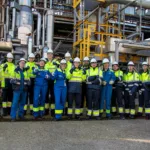
How to meet the ambitious 2050 climate targets and cut transport emissions responsible for a quarter of all European CO2 emissions by 90%? This decade will be crucial to develop cleaner mobility in Europe and globally, and the chemical industry will certainly play a key role in this unprecedented transformation.
During Cefic Digital Dialogue on 27 October 2021, Kristian Hedberg (Head of Unit Sustainable and Intelligent Transport, European Commission), Eric-Mark Huitema (Director General, European Automobile Manufacturers Association), Pascal Chalvon (Chief Sustainability Officer, Solvay), William Todts (Director General, Transport and Environment NGO) and Stefan Neugebauer (Director Global Research Cooperation, BMW Group) discussed the challenges and opportunities for the future of sustainable mobility in Europe.
What is the role of the chemical industry in the EU green mobility transition?
Opening the discussion, Kristian Hedberg, Head of Unit Sustainable and Intelligent Transport at the European Commission said that the European chemical industry will play a crucial role in driving the development of sustainable mobility: “The chemical industry occupies a special place here [in the green mobility transition], it is the chemical industry that will provide energy storage solutions regardless if they will store chemical energy or electricity. In all our mobility decarbonisation efforts, we need the chemical industry to innovate, to deliver more efficient, more economical, more sustainable solutions for energy storage, for bio or synthetic fuels production, hydrogen carriers, lightweight materials for vehicles, materials for hydrogen storage and others.”
What do we need to enable the massive transformation of the transport sector?
Pascal Chalvon, Chief Sustainability Officer at Solvay, agreed that the chemical industry has a key role to play in developing and mainstreaming the critical building blocks to deliver the sustainable mobility. According to Mr. Chavlon, there are three main enablers of the transition – technology, circularity and demand.
Stephan Neugebauer, Director Global Research Cooperation at BMW Group is convinced that the transformation of the transport sector cannot be achieved by ideologically driven regulation or restrictions, but only through technical innovation. The battery electric powertrain and diffused electric powertrain using hydrogen will be the most important powertrains, but not exclusively – it is necessary to develop more technologies like e-fuels as electricity carrier and create a competitive environment.
The Director General of the European Automobile Manufacturers Association (ACEA) Eric-Mark Huitema also highlighted the importance of the innovation and a coherent regulatory framework to enable it: “If we want to produce the batteries and fuel cell cars, we need to make sure that the chemicals supporting the fuel cells and batteries are not forbidden at the same time.”
William Todts, Director General of the Transport and Environment NGO recognised that tremendous progress had been made in the last 10 years in innovation of the automotive and chemicals industry. Sales of electric vehicles have boomed and continue to increase as a result of European regulation, which is a good learning example showing how we can deliver if we have clear targets.
The combination of battery-electric and fuel cells will get us to zero emissions much faster than liquid fuels. Electromobility is the future of transport and chemical industry needs to get onboard with this strategy and embrace the electricity solution, said William Todts.










